La Vuelta a España 2024 Route Preview: The 79th version of the Vuelta a España will begin in Lisbon on Saturday 17 August and end in Madrid on Sunday 8 September. The final Grand Tour of the 12 months has a really completely different path to earlier years, however as with the opposite three week races, the ultimate week is extraordinarily arduous. You might say the primary two weeks are simpler than typical, but it surely’s all a carrying down course of earlier than the murderous finale. Listed here are the stage particulars.

A Visma | Lease a Bike full podium isn’t anticipated in 2024
That is the fifth time la Gran Salida can be outdoors of Spanish borders. This 12 months, the Vuelta will begin from Lisbon for the second time in historical past. The Portuguese capital additionally hosted the opening of the Tour of Spain in 1997, the 12 months Alex Zülle was the ultimate general winner. That 12 months the primary stage was a street stage, this 12 months it’s a 12 kilometre time trial.
The Vuelta a España can be in Portugal for 3 days, adopted by a mountain stage in Extremadura. Lately the Vuelta has used unknown climbs on this area. In 2024, will probably be the Pico Pitolero (13.8km at 7%). After that, there are a selection of hilly and dash levels in Andalusia and the so GC males can take a again seat, though there could possibly be motion on stage 9 to Granada.

Roglič and Kuss is likely to be preventing it out once more
Stage 12 sees an actual mountain end in Galicia. The Vuelta is then within the north of Spain and is extraordinarily arduous. Daily the Vuelta has Cat.1 or HC climbs, the hardest within the Picos mountains. The levels with summit finishes on the Lagos de Covadonga (stage 16) and Picón Blanco (stage 20) can be arduous and decisive.

Sep Kuss can experience a great TT when he must
The Vuelta ends with a time trial in Madrid, 22 kilometres which they hope can be an exhilarating conclusion.
 The 2024 Vuelta a España map
The 2024 Vuelta a España map
The 79th Vuelta a España Stage Particulars:
21 levels
3,265 kilometres
Begin in Lisbon
End in Madrid
Relaxation days on Monday 26 August and Monday 2 September
2 time trials
24 time trial kilometres
9 mountain finishes
No levels longer than 200 kilometres
16 levels between 150 and 200 kilometres
2 hors class climbs
20 x 1st class climbs
15 x 2nd class climbs
14 x third class climbs
3 x 4th class climbs.

Lagos de Covadonga makes its return on stage 16
Stage 1
Saturday 17 August, Lisbon – Oeiras (12km, ITT)
La Vuelta a España begins on Saturday 17 August in Lisbon, Portugal. That is the fifth time that the Vuelta has began outdoors Spain, after Gran Salidas in Lisbon (1997), Assen (2009), Nîmes (2017) and Utrecht (2022). The primary stage is a 12 kilometre time trial to Oeiras.
 Stage 1 map
Stage 1 map
The Vuelta doesn’t go to the historic centre of the capital, however the suburb of Restelo after which west alongside the coast to Oeiras. The beginning is from Lisbon’s historic Praça do Império. From there, the riders go straight to the coast. They may even move the royal gardens. From then on, it’s virtually straight to the end in Oeiras. The route isn’t technical, however contemplating latest Vuelta, that is most likely a good suggestion.
 Stage 1 profile
Stage 1 profile
Stage 2
Sunday 18 August, Cascais – Ourem (191km)
The sprinters have an opportunity on stage 2 of the 2024 Vuelta. The peloton races north by way of Portugal from Cascais to Ourem, out of the Lisbon space and in to Santarem, on primarily flat roads near the coast. There are two fourth-category climbs: After 9 kilometres, there may be the summit of the Alto do Lagoa Azul and within the finale, the Alto da Batalha is nineteen kilometres from the end. Pure sprinters might need hassle on the final climb, however the ones with some climbing of their legs ought to recover from. The final 20 kilometres are flat or descending to the hilly end in Ourém. There are hardly any bends within the final kilometres of the stage, so the sprinter’s groups ought to be capable of get their trains in line.
 Stage 2 profile
Stage 2 profile
Stage 3
Monday 19 August, Lousa – Castelo Branco (182km)
The third stage is the final in Portugal, however the first with critical climbing. It is likely to be too early for any massive time variations amongst the GC males within the 182 kilometres between Lousa and Castelo Branco, because the final 50 kilometres are virtually flat. The stage begins in Lousa and heads to the most important mountain vary within the Portugal: the Serra da Estrela.
 Stage 3 map
Stage 3 map
There most likely received’t be a lot GC motion because the peloton will solely climb to round 900 metres altitude on to the Alto de Teixeira. There are nonetheless 100 comparatively simple kilometres to the end in Castelo Branco, with solely the lengthy, however not steep climb, the Alto de Alpedrinha. There’s nonetheless a bit over an hour of racing to the end in Castelo Branco and the exit of Portugal.
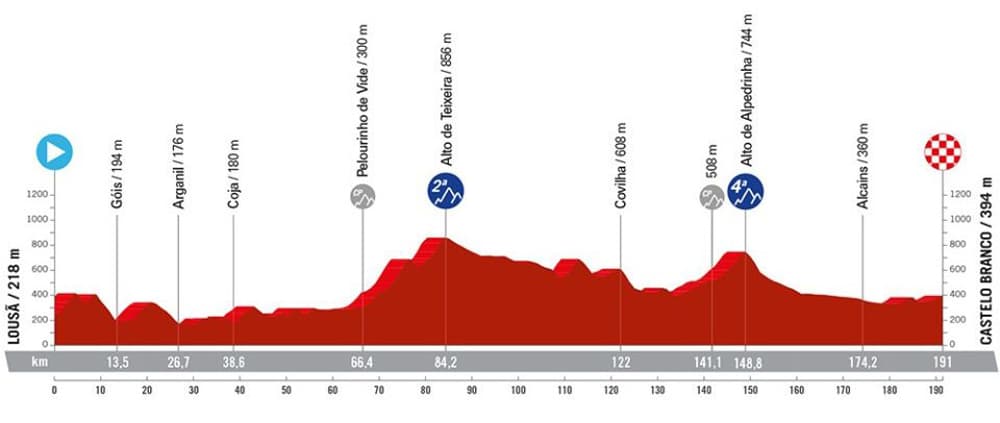 Stage 3 profile
Stage 3 profile
Stage 4
Tuesday 20 August, Plasencia – Pico Pitolero (167 km)
The primary mountain stage within the 2024 Vuelta is on Tuesday twentieth of August, when the GC riders will battle it out on the Pico Pitolero for the purple jersey and treasured seconds. The 167 kilometre stage from Plasencia to Pico Pitolero is the primary stage in Spain and is troublesome proper from the beginning, because the riders need to climb the Puerto de Cabezabellosa (Cat.2). After a brief descent, the subsequent climb, the Alto de Piornal (Cat.2) comes instantly. After a simple center part, the peloton climbs the Pico Pitolero for the primary time in la Vuelta. It’s 13.8 kilometres lengthy and has a mean gradient of seven%, however within the final 4 kilometres, the gradient is 10% or extra and the street floor is tough concrete. The utmost gradients go as much as 20%. This could form the GC for the remainder of the race.
 Stage 4 profile
Stage 4 profile
Stage 5
Wednesday 21 August, Fuente del Maestre – Sevilla (170km)
The fifth stage is 170 kilometres lengthy and begins in Extremadura. The stage doesn’t have any categorised climbs, however the first 100 kilometres of the stage are undulating. The beginning in Fuente del Maestre is at an altitude of 450 metres and the stage altitude varies between 300 to 750 metres.
 Stage 5 map
Stage 5 map
The ultimate is flat and there may be hardly any climbing within the final 45 kilometres. The peloton comes into the centre of Sevilla from the north of town for the sprinters to have one other shot at victory.
 Stage 5 profile
Stage 5 profile
Stage 6
Thursday 22 August, Jerez de la Frontera – Yungquera (181km)
The Vuelta is now within the deep south. Stage 6 begins in Jerez de la Frontera on Thursday. This space is pretty flat and climbing doesn’t actually begin till after 50 kilometres, on the Cat.1 climb of the Puerto del Bojar (15km at 5.7%) with most gradients of 10%. That is the hardest climb of the day, however the stage solely actually begin then, with 4 extra Cat.3 climbs. First is the Alto de Ronda (5.9km at 4.6%), then the Puerto del Viento (6.9km at 4.1%) and the better Puerto Martinez (3.8km at 5.5%), the final is the Alto de las Abejas (9.3km at 4%). The ultimate climb isn’t troublesome. The end is in Yungquera for the primary time.
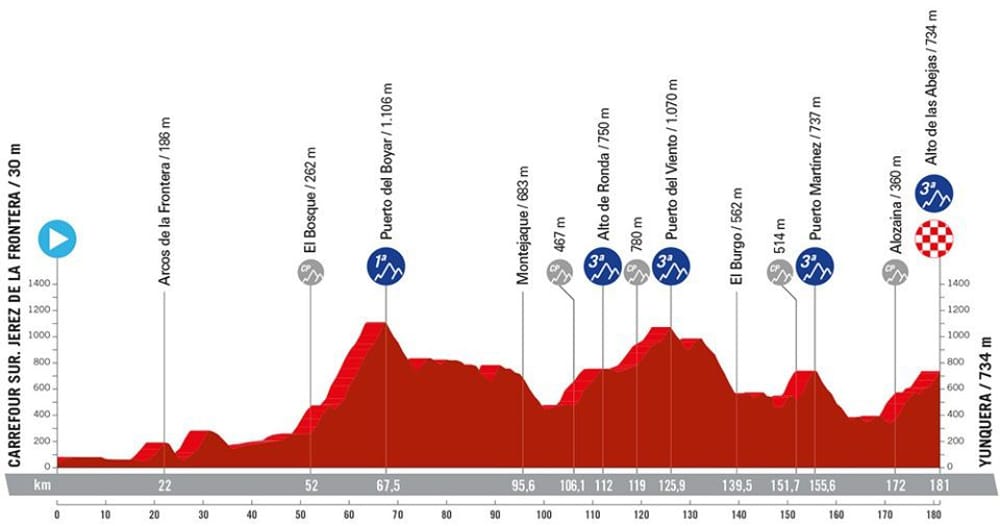 Stage 6 profile
Stage 6 profile
Stage 7
Friday 23 August, Archidona – Cordoba (179km)
The seventh stage is on rolling roads and can most likely not trigger any issues for the GC riders. There’s a Cat.2 climb 30 kilometres from the end. From the stage begins in Archidona, there may be some climbing within the first 140 kilometres, however nothing arduous. The toughest a part of the stage is the Alto del 14%, sure, that’s the title of the climb and its most gradient. The climb is 8.4 kilometres and has a mean gradient of 5.3%. It’s downhill to the end in Cordoba.
 Stage 7 profile
Stage 7 profile
Stage 8
Saturday 24 August, Ubeda – Cazorla (159km)
The eighth stage begins in Úbeda and finishes in Cazorla after 159 kilometres. From Úbeda, the primary 70 kilometres go northeast to the Guadalquivir river. After 105 kilometres, the primary climb of the day is the Puerto Mirador de la Palomas (7.3km at 5.9%), a Cat.2. After the Puerto Mirador de la Palomas, there’s a lengthy descent to Peal de Becerro, from the place the finale actually begins. From an altitude of 500 metres, the climb goes to an altitude of 900 metres. After a brief descent, the ultimate climb to Cazorla begins. It’s 4.2 kilometres lengthy with a mean gradient of 8.2%. The GC males ought to trigger a while variations right here. In 2015, Esteban Chaves received forward of general chief Tom Dumoulin and took over his chief’s jersey.
 Stage 8 profile
Stage 8 profile
Stage 9
Sunday 25 August, Motril – Granada (179km)
The second actual mountain stage can also be the final stage earlier than the primary relaxation day. The stage goes from Motril to Granada, 178 kilometres. That is the final stage in Andalusia earlier than the riders transfer to Galicia within the north. This mountain stage has three Cat.1 climbs and goes as much as an altitude of virtually 1,700 metres twice. The toughest a part of the stage is especially within the second half, as the primary 80 kilometres are pretty simple. After 88 kilometres, the primary climb of the day is the Puerto de El Purche (8.8km at 7.7%).
 Stage 9 map
Stage 9 map
Within the final 70 kilometres, the Alto de Hazallenas comes twice. This climb may be very arduous, with a mean gradient of 9.2% over a distance of seven.5 kilometres. On the midway mark, it peaks at 20% and common percentages of nicely over 10%. This climb has been on the Vuelta route earlier than: Thymen Arensman received in 2022 on the Alto de Hoya de la Mora, the primary ten kilometres of that are on the street of the Alto de Hazallenas. Miguel Angel Lopez and Chris Horner additionally received right here a couple of years earlier.
 Stage 9 profile
Stage 9 profile
Relaxation Day No.1
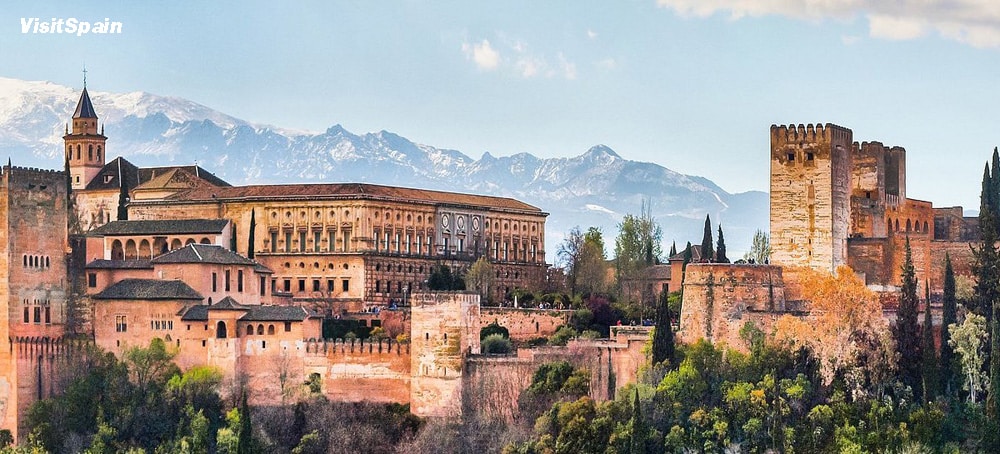
No relaxation day in Granada – The Vuelta heads north
Stage 10
Tuesday 27 August, Pontareas – Baiona (160km)
The Vuelta strikes from the far south to the very north of Spain on the primary relaxation day. On Tuesday, the race continues with a stage in Galicia, near the Portuguese border, a stage of 160 kilometres, with 4 categorised climbs. Two of them are Cat.1, however the peloton by no means goes increased than 805 metres. The climbs are primarily from sea degree. After 12 kilometres there may be the Alto de Fonfría (15.5km at 4.5%), the subsequent doesn’t come til the final 60 kilometres. The finale is available in three elements and turns into more and more troublesome. First there may be the Alto de Vilachán (6.6km at 5.4%), then the Alto de Mabia (6km at 5.7%) and eventually the Alto de Mougás (9.9km at 6.1%). If the assaults come on the Mougás, the flatter remaining kilometres can be fairly hectic.
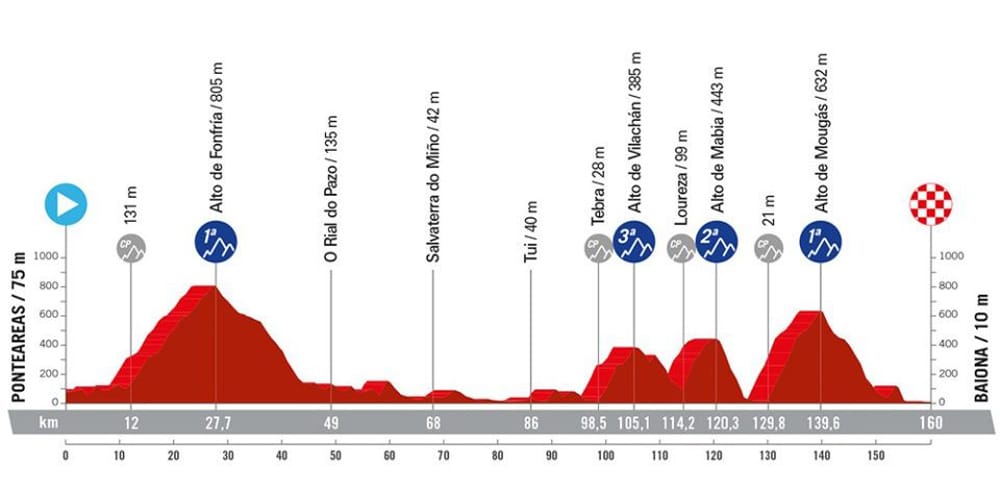 Stage 10 profile
Stage 10 profile
Stage 11
Wednesday 28 August, Padron – Padron (164km)
The second stage in Galician soil is just like the day before today’s stage, though the 2 Cat.1 climbs are lacking. There are 4 climbs within the route, none of that are increased than 500 metres. The beginning and the end of the stage are on the technological centre of Padron, which is among the final stops on the Camino en path to Santiago de Compostela. The stage can be troublesome to manage as a result of climbs. The primary categorised climb is the Puerto San Xusto after 42 kilometres. It climbs for over 10 kilometres with a mean gradient of 4.2%. After this, the peloton will move the end line on the Puerto Aguasantas twice. This climb is sort of 9 kilometres with a mean gradient of 4.6%. As soon as the Puerto Aguasantas has been summited for the second time, there are nonetheless virtually 50 kilometres to go. These are primarily descending or flat, till the Puerto Cruxeiras. This climb is just a Cat.3, however the race may explode right here. The climb is a sort of Mur de Huy, at 1.5 kilometres and a mean gradient of 9.2%. After the highest there’s a descent to the end.
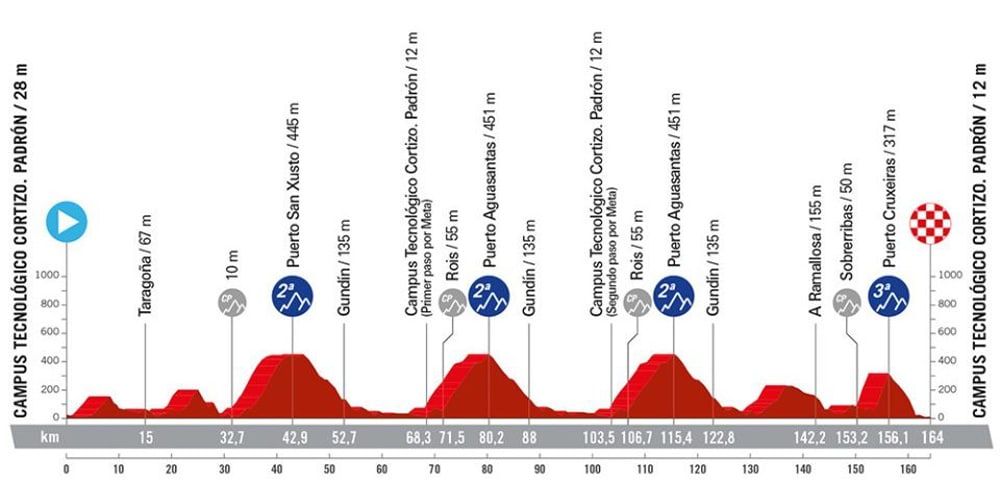 Stage 11 profile
Stage 11 profile
Stage 12
Thursday 29 August, Ourense – Montana de Manzaneda (133km)
The end of the twelfth stage is on the ski resort of Montana de Manzaneda. The stage goes from 224 metres to an altitude of 1,500 metres. There is just one categorised climb on the route, however the remainder of the stage is flat. Within the first few kilometres there may be numerous climbing. The primary 3 kilometres are a climb to Montealegre with a mean gradient of round 8%. The peloton rides to an altitude of virtually 700 metres.
 Stage 12 map
Stage 12 map
After 110 kilometres, the climb to the ski resort in Manzaneda begins (16km at 4.7%). The ultimate climb isn’t too steep, however that modifications at it will get nearer to the highest. The street rises at round 3% within the first few kilometres, within the remaining kilometres it’s by no means beneath 7%.
 Stage 12 profile
Stage 12 profile
Stage 13
Friday 30 August, Lugo – Puerto de Ancaras (171km)
Stage 13 is the final day in Galicia and there are a couple of massive climbs on the menu, earlier than the end on the Puerto de Ancaras in Cantabria, a climb of crushing gradients. The beginning of the stage is kind of simple, with climbs of Cat.3 and Cat.2 that shouldn’t trouble anybody. The Alto Campo de Arbre (6km at 5.1%) and the Alto O Portel (7.8km at 5.2%) will not be too steep. The Puerto de Lumeras (6.7km at 6%) is a warm-up for the Puerto de Ancares, which is available in 8 kilometres.
The Puerto de Ancaras
The Puerto de Ancares (7.6km at 8.9%) has a gradient of 9% and turns into steeper and steeper in sections. After the third kilometre, the gradient by no means drops beneath 10%. The penultimate kilometre is the hardest, with a mean share of 14% and sections above 20%.
 Stage 13 profile
Stage 13 profile
Stage 14
Saturday 31 August, Villafrance del Bierzo – Villablino (199km)
The 14th stage begins in Villafrance del Bierzo. The primary hundred kilometres are once more pretty simple. Midway by way of the stage, there may be the Puerto de Cerredo. This climb rises about 9 kilometres with a mean gradient of 4.1% and won’t trigger too many issues. On the prime the riders will enter Asturias. On this stage, the Puerto de Leitariegos (24km at 4.1%) is the principle impediment.
 Stage 14 map
Stage 14 map
This begins after a protracted descent in direction of Bimeda at 39 kilometres from the end. There are 24 kilometres of climbing, but it surely by no means actually will get very steep, it ought to take about an hour to summit. After the highest, there may be one other 16 kilometres of descent to the end in Villablino. The stage could possibly be decisive, however the riders figuring out that on Sunday they are going to be a climb of an HC class?
 Stage 14 profile
Stage 14 profile
Stage 15
Sunday 1 September, Infiesto – Cuitu Negru (142km)
Stage is an actual terror for all of the riders. A stage of 142 kilometres, with the end line on prime of the Cuitu Negru in Valgrande-Pajares. An actual Asturian climb. The asphalt street to the highest was constructed particularly for the Vuelta fifteen years in the past. From Infiesto, the peloton has a rolling street to the three climbs earlier than the Cuitu Negru. After 28 kilometres, they begin the Alto de la Colladiella (7.8km at 7.1%), after which the Alto de Santo Emiliano (5.4km at 5.6%) shortly follows. As a warm-up, the peloton tackles the Alto de la Colladiella once more after 80 kilometres. There are nonetheless about 37 kilometres to go to the foot of the Cuitu Negru.
Cuitu Negru
After a protracted descent, there may be the Puente de Fierros, the place the 19 kilometre remaining, the Cuitu Negru (19.5km at 5.2%) begins. The common gradient provides a false image of the climb as the primary 7 kilometres will not be too taxing, however after that it turns into very troublesome. Eight kilometres from the highest, the street rises at 11%, and after that the climb turns into an increasing number of troublesome. The final 2.5 kilometres rise at greater than 12% and simply earlier than the highest it goes as much as 24%.
 Stage 15 profile
Stage 15 profile
Relaxation Day No.2

The Vuelta peloton can be glad of a break day in Asturias
Stage 16
Tuesday 3 September, Luanco – Lagos de Covadonga (181km)
The sixteenth stage finishes on the Lagos de Covadonga. The beginning of the stage is within the Asturian coastal city of Luanco after which goes by way of the hilly northern Spanish coast previous Gijón to the attractive mountain vary of the Picos de Europa. Earlier than the ultimate HC climb, there are two Cat.1 mountains. The primary is the Mirador del Fito (7km at 8.1%) after 70 kilometres and the second, the Collada Llomenia (7.6km at 9.3%).
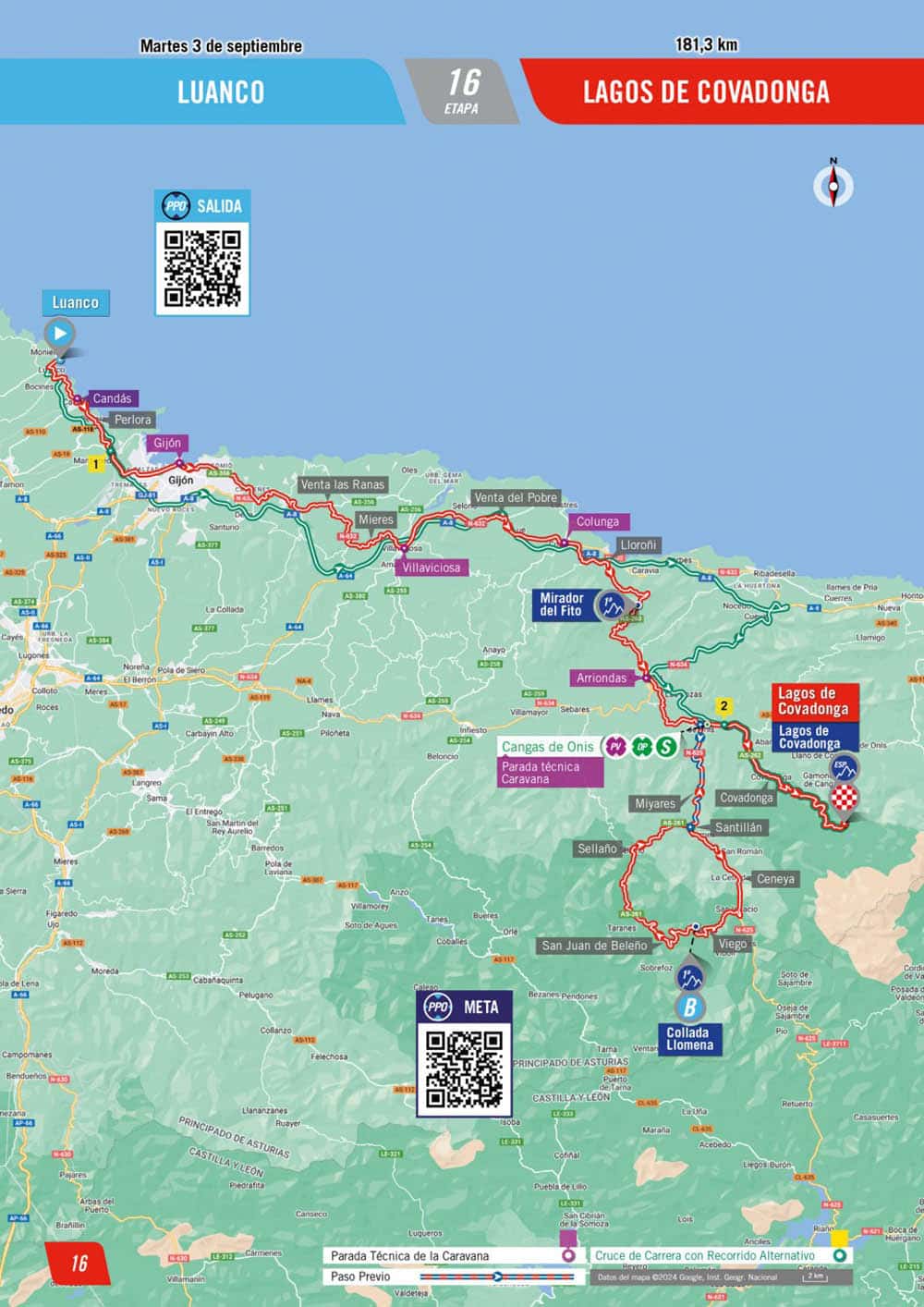 Stage 16 map
Stage 16 map
After the Llomenia there are 40 kilometres to the bottom of the Lagos de Covadonga for 12.5 kilometres to the glacial lakes Lago de Enol and Lago de Ercina. The Lagos de Covadonga (12.5km at 6.9%) and is a protracted arduous climb. Within the first 7 kilometres the street rises at 10%. The final a part of this part has ramps of greater than 15%. The final kilometres of the climb are a bit flatter and final half to the end is downhill.
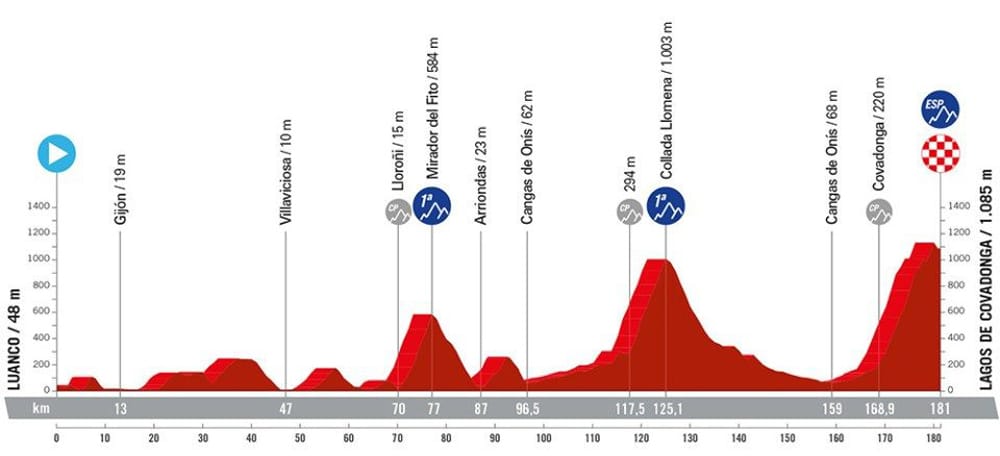 Stage 16 profile
Stage 16 profile
Stage 17
Wednesday 4 September, Arnuero – Santander (143km)
In the midst of the robust remaining week, the sprinters are allowed to go for victory on stage 17. There are two Cat.2 climbs, however the final 50 kilometres of the stage are just about flat. The stage begins in Arnuero and finishes within the Cantabrian capital of Santander. The primary a part of the beginning must be fairly calm, however then the stage has a hilly zone between kilometres 40 and 70. This consists of the Alto de la Estranguada (7.8km at 6.2%) and the Alto del Caracol (5.1km at 6.6%), each Cat.2. Nothing too extreme, so the sprinters will most likely be secure. After the Alto del Caracol it’s primarily downhill and flat to the end in Santander, the place there must be a bunch dash. The Vuelta has completed in Santander 35 occasions. The final stage end was in 2003 and Alessandro Petacchi was the victor.
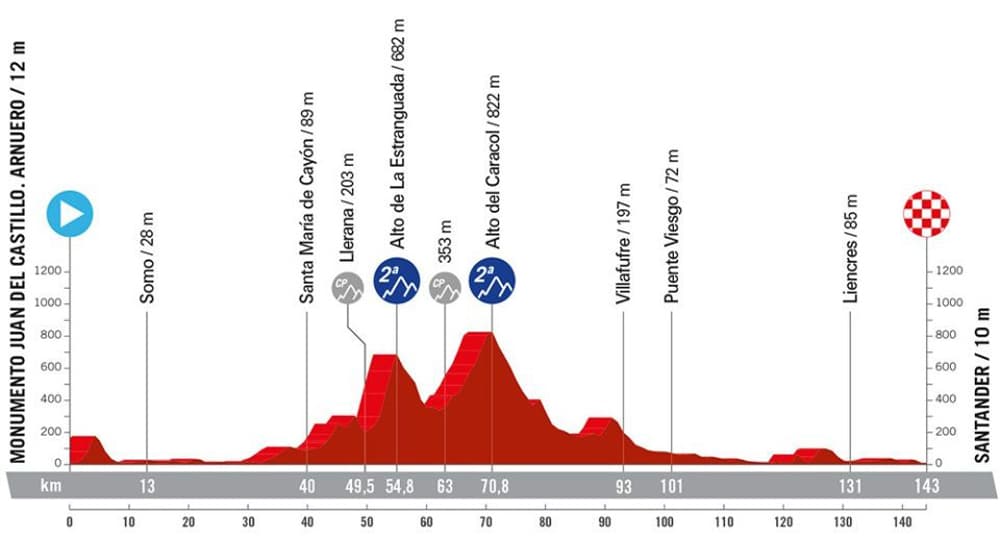 Stage 17 profile
Stage 17 profile
Stage 18
Thursday 5 September, Vitoria-Gasteiz – Maeztu (175km)
The Vuelta can be within the Basque Nation for a day for stage 18, between Vittoria Gasteiz and Maeztu. This must be a stage for an escapees, with a couple of Basque climbs within the remaining. The beginning is within the Basque capital of Vitoria-Gasteiz. The largest climbs within the stage are after 77 kilometres and 130 kilometres; the Alto de Rivas de Tereso (11.1km at 3.4%) and the Puerto Herrera (5.5km at 8.4%).
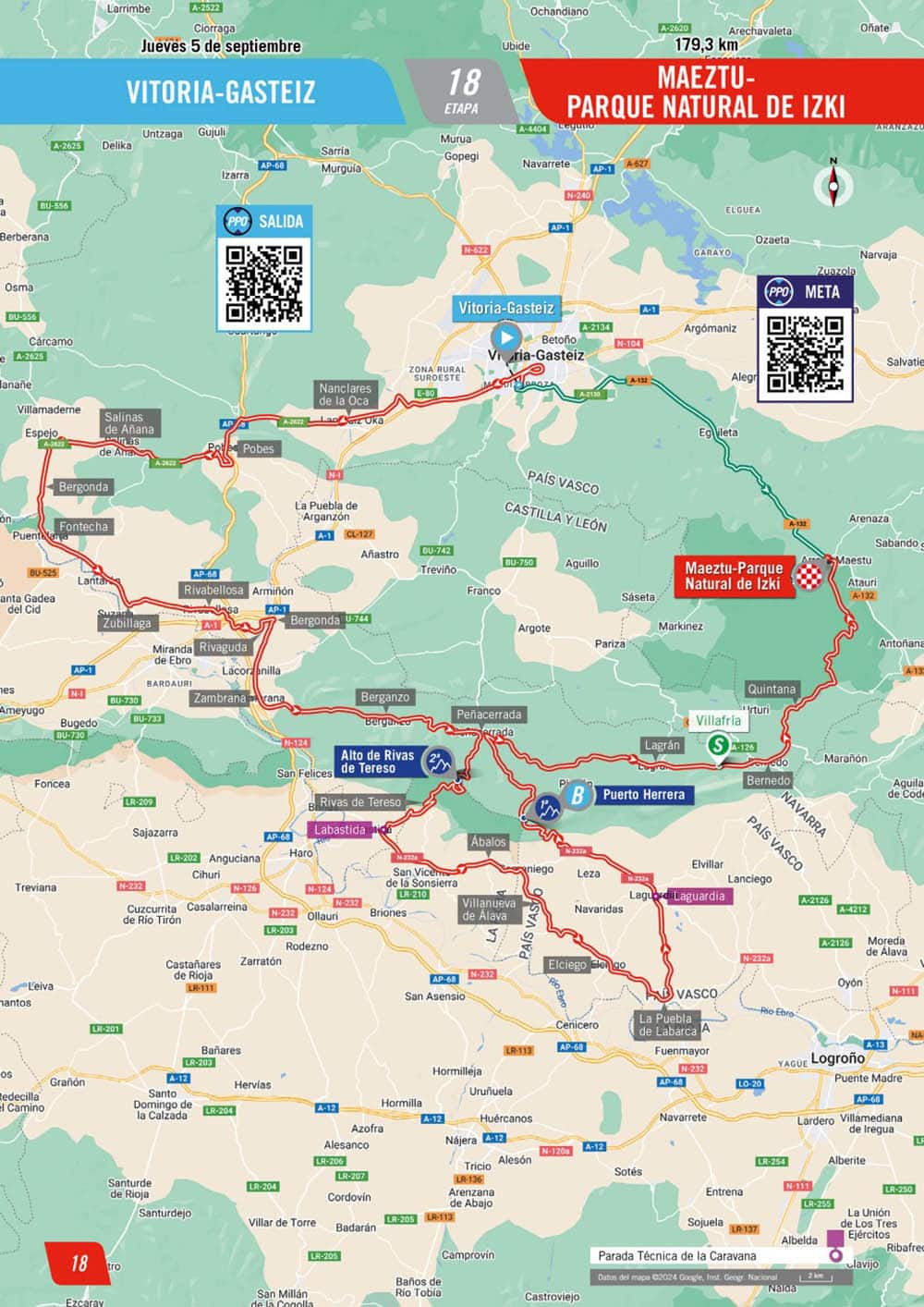 Stage 18 map
Stage 18 map
The second climb may trigger a break up. After the Puerto Herrera, there are 45 kilometres with none categorised climbs to the end, however it’s not flat. The street rises for 3 kilometres at 5%, 7.5 kilometres from the end.
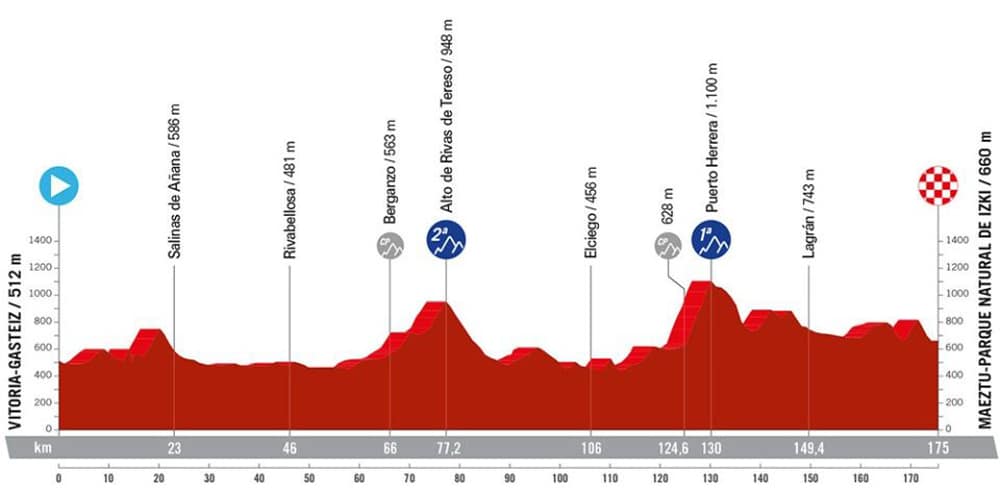 Stage 18 profile
Stage 18 profile
Stage 19
Friday 6 September, Logroño – Alto de Moncalvillo (168km)
There are two main mountain levels earlier than Madrid. The peloton leaves the Basque Nation on Friday, however stays within the north of Spain within the Castile and Leon. Stage 19 has a summit, the primary within the third week. After the beginning in Logroño, the 8 kilometre remaining climb to the Alto de Moncalvillo (11.3km at 7.6%) comes after 160 kilometres. There’s additionally the Puerto de Pradilla, however this Cat.3 climb doesn’t have any super-steep gradients. After the Puerto de Pradilla it’s primarily downhill to the foot of the Alto de Moncalvillo.
The final time on the Alto de Moncalvillo
This climb is hard, with a mean gradient of seven.6%. In direction of the highest the gradients are by no means beneath 10%. There must be a battle for the general right here.
 Stage 19 profile
Stage 19 profile
Stage 20
Saturday 7 September, Villarcayo – Picon Blanco (171km)
The final bunch stage is within the province of Burgos and has greater than 4,000 metres of climbing. After 35 kilometres, the Las Estacas de Truebla (9.3km at 3.1%) is the primary climb of the day, adopted shortly by the Puerto de La Braguia (6.1km at 5.6%). These two climbs are the simplest of the day. After that, there are 5 Cat.1 or Cat.2 climbs within the final 100 kilometres. Midway by way of the stage, the Alto del Caracol (10.5km at 5.5%), the Portillo de Lunada (14km at 6.2%) and the Portilla de la Sia (7.2km at 5.8%) will loosen the legs.
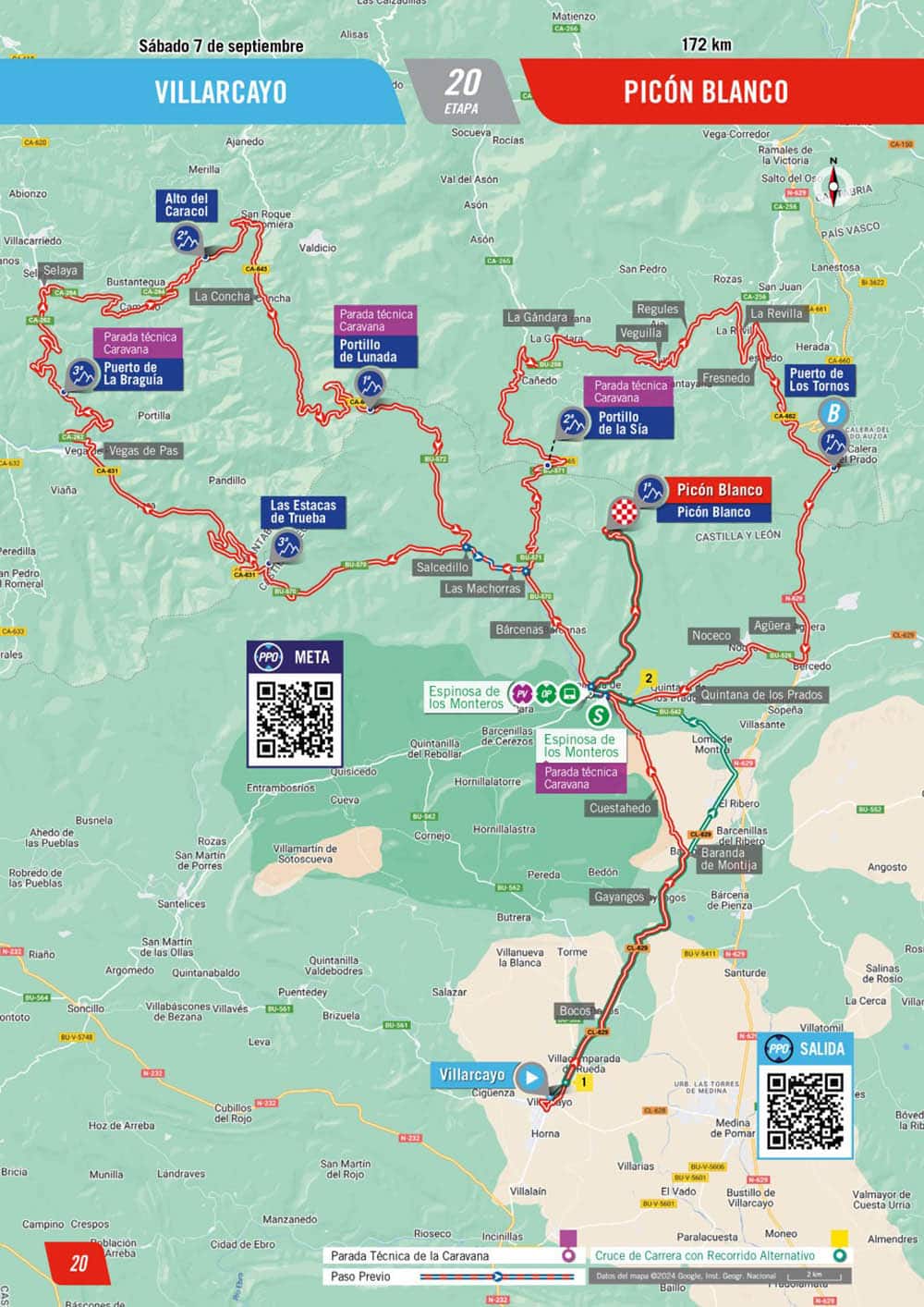 Stage 20 map
Stage 20 map
There’s a lengthy descent in direction of the finale, which begins with the Puerto de Los Tornos (13.2km at 5.4%). The riders will then have climbed over 3,000 metres, however with none insanely steep gradients, they’ll come later. In Espinosa de los Monteros, the ultimate climb to Picon Blanco (7.6km at 9.2%) begins after 162.5 kilometres. This climb barely has any gradients beneath 10%, besides within the first kilometre and the final kilometre. From kilometre 3.5, the climb turns into actually robust, with sections approaching 20%.
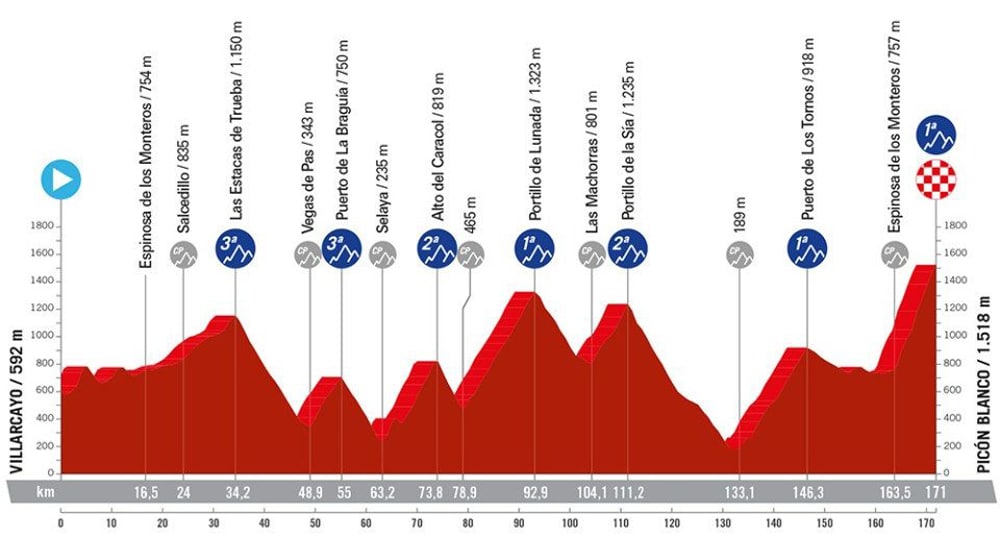 Stage 20 profile
Stage 20 profile
Stage 21
Sunday 8 September, Madrid – Madrid (22km, ITT)
After years of a dash end for the final stage, this 12 months ends with a 22 kilometre time trial by way of the Spanish capital. The time trial route has no climbs because the centre of Madrid it’s largely flat. The time trial can also be not significantly technical and is ridden in a southerly course in direction of the centre.
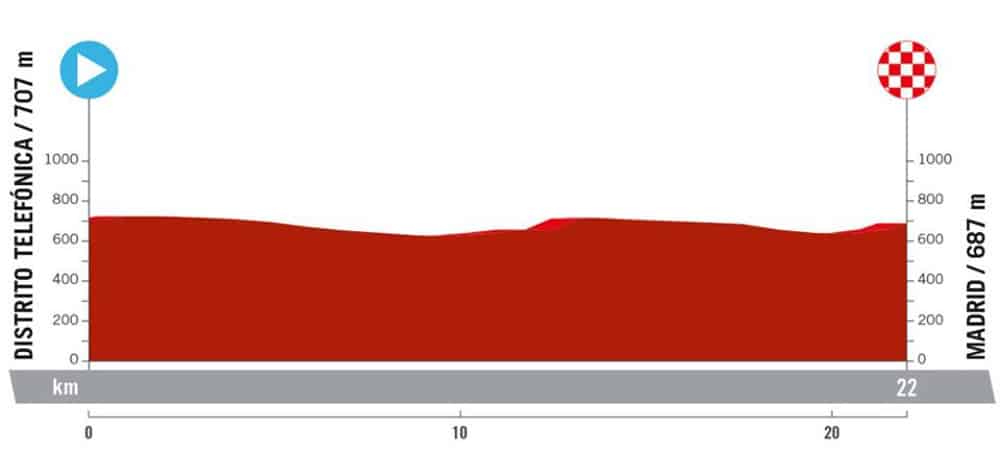 Stage 21 profile
Stage 21 profile
The beginning of the time trial is on the headquarters of the Spanish telecom big Telefónica (Movistar), from the place the riders will enter the outdated metropolis centre by way of the M-612. After about 12 kilometres, the riders come into Madrid by way of the Tétuan district and can move the Santiago Bernabéu soccer stadium. 4 kilometres from the end there may be the fountain of Cibele after which the boulevard Paseo del Prado. On the botanical gardens, 2 kilometres from the end, the riders will make a 360-degree flip again to the Paseo del Prado and the fountain of Cibele and the end is on the Gran By way of. Who can be carrying the Purple chief’s jersey? We are going to record the ‘Prime Contenders’ quickly.

No dash in Madrid this 12 months
Vuelta a España 2024 Phases:
Stage 1. Lisbon – Oeiras 12.0km ITT
Stage 2. Cascais – Ourém 194.0km flat
Stage 3. Lousã – Castello Branco 191.2km hilly
Stage 4. Plasencia – Pico Villuercas 170.4km mountains
Stage 5. Fuente del Maestre – Seville 177.0km flat
Stage 6. Jerez de la Frontera – Yunquera 185.5km hilly
Stage 7. Archidona – Córdoba 180.2km hilly
Stage 8. Úbeda – Cazorla 158.7km hilly
Stage 9. Motril – Granada 178.2km mountains
26-8 relaxation day
Stage 10. Pontearas – Baiona 159.6km hilly
Stage 11. Padrón – Padrón 166.4km hilly
Stage 12. Ourense – Cabeza de Manzaneda 137.4km mountains
Stage 13. Lugo – Puerto de Ancaras 175.6km mountains
Stage 14. Villafranca del Bierzo – Villablinokm 200.4km mountains
Stage 15. Infiesto – Cuitu Negru 142.9km mountains
2-9 relaxation day
Stage 16. Luanco – Lagos de Covadonga 181.3km mountains
Stage 17. Arnuero – Santander 141.5km flat
Stage 18. Vitoria Gasteiz – Maeztu 179.3km hilly
Stage 19. Logroño – Alto del Moncalvillo 173.2km mountains
Stage 20. Villarcayo – Picón Blanco 172.0km mountains
Stage 21. Madrid – Madrid 24.6km ITT
*** Keep PEZ for the ‘Vuelta Rider Preview’ coming quickly. ***
The perfect of the 2023 Vuelta a España
# Because of La Vuelta for the profiles and details and PCS and WielerFlits for the opposite information. #


